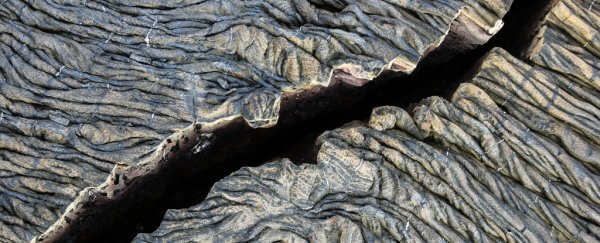
Earth is far from a solid mass of rock. The outer layer of our planet – known as the lithosphere – is made up of more than 20 tectonic plates; as these gargantuan slates glide about the face of the planet, we get the movement of continents, and interaction at the boundaries, not least of which is the rise and fall of entire mountain ranges and oceanic trenches.
Yet there's some debate over what causes these giant slabs of rock to move around in the first place.
Amongst the many hypotheses put forward over the centuries, convection currents generated by the planet's hot core have been discussed as an explanation, but it's doubtful whether this effect would produce enough energy.
A newly published study looks to the skies for an explanation. Noting that force rather than heat is most commonly used to move large objects, the authors suggest that the interplay of gravitational forces from the Sun, Moon, and Earth could be responsible for the movement of Earth's tectonic plates.
Key to the hypothesis is the barycenter – the center of mass of an orbiting system of bodies, in this case that of Earth and the Moon. This is the point around which our Moon actually orbits, and it's not directly in the center of mass of our planet, which we call the geocenter.
Instead, the location of the barycenter within Earth changes over the course of the month by as much as 600 kilometers (373 miles) because the Moon's orbit around Earth is elliptical due to our Sun's gravitational pull.
"Because the oscillating barycenter lies around 4,600 kilometers [2,858 miles] from the geocenter, Earth's tangential orbital acceleration and solar pull are imbalanced except at the barycenter," says geophysicist Anne Hofmeister, from Washington University in St. Louis.
"The planet's warm, thick and strong interior layers can withstand these stresses, but its thin, cold, brittle lithosphere responds by fracturing."
Further strain is added as Earth spins on its axis, flattening out slightly from a perfect spherical shape – and these three stresses from the Moon, Sun, and Earth itself combine to cause the shifting and the splitting of tectonic plates.
"Differences in the alignment and magnitude of the centrifugal force accompanying the solar pull as Earth undulates in its complex orbit about the Sun superimpose highly asymmetric, temporally variable forces on Earth, which is already stressed by spin," the researchers write.
What's happening underneath the surface is that the solid lithosphere and the solid upper mantle are being spun at different speeds because of these stresses and strains, the researchers report – all due to our particular Earth-Moon-Sun configuration.
"Our uniquely large Moon and particular distance from the Sun are essential," says Hofmeister.
Without the Moon, and the shifts it causes between the barycenter and the geocenter, we wouldn't see the tectonic plate activity we get on Earth's surface, the researchers argue. As the Sun's gravitational pull on the Moon is 2.2 times greater than Earth's pull, it will get drawn away from our planet over the next billion years or so.
That said, the gravitational forces at play still need Earth's hot interior for all this to work, the researchers argue.
"We propose that plate tectonics result from two different, but interacting, gravitational processes," they write. "We emphasize that Earth's interior heat is essential to creating the thermal and physical boundary layer known as the lithosphere, its basal melt, and the underlying low-velocity zone."
To further validate the hypothesis outlined in their study, the researchers apply their analysis to several rocky planets and moons in the Solar System, none of which have had confirmed tectonic activity to date.
Their comparison between Earth and the other major celestial bodies in the Solar System reveals a potential explanation for why we haven't detected tectonic activity on any of the major moons or rocky planets so far. The one closest to Earth in all the necessary parameters, however, is Pluto.
"One test would be a detailed examination of the tectonics of Pluto, which is too small and cold to convect, but has a giant moon and a surprisingly young surface," says Hofmeister.
The research has been published in GSA Special Papers.
No comments:
Post a Comment